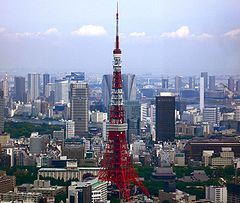Heisei (平成 ?) is the current era name in Japan. The Heisei era started on January 8, 1989, the first day after the death of the reigning Emperor, Hirohito. His son, Akihito, succeeded to the throne. In accordance with Japanese customs, Hirohito was posthumously renamed "Emperor Shōwa" on January 31, just as were Mutsuhito (Emperor Meiji) and Yoshihito (Emperor Taishō).
Thus 1989 corresponds to Shōwa 64 up to the 7th day of the first month (January 7) and to Heisei 1 (平成元年 ,Heisei gannen?, gannen means "first year") since the 8th day of the first month (January 8). 2009 is Heisei 21. A quick way to convert the current year to Heisei is to take the last two digits and add 12. Example for 2009: 09+12 = Heisei 21.
History and meaning[]
On January 7, 1989, at 7:55 AM, the grand steward of Japan's Imperial Household Agency, Shōichi Fujimori, officially announced Emperor Shōwa's death, and revealed details about his cancer for the first time. Shortly after the death of the Emperor, Keizō Obuchi, then Chief Cabinet Secretary and later Prime Minister of Japan, publicly announced the end of the Shōwa era, and heralded the new era name "Heisei" for the new incoming Emperor, and explained the meaning of the name.
According to Obuchi, the name "Heisei" was taken from two Chinese history and philosophy books, namely Records of the Grand Historian (史記 Shiji) and the Classic of History (書経 Shujing). In the Shiji, the sentence "内平外成" (peace inside and prosperity outward) appears in a section honoring the wise rule of the legendary Chinese Emperor Shun. In the Shujing, the sentence "地平天成" (the land is peaceful and the sky is clear) appears. By combining both meanings, Heisei is intended to mean "peace everywhere". The Heisei era went into effect immediately after the announcement of the new emperor on January 8, 1989.

Tokyo skyline
Events[]
1989 marked the culmination of one of the most rapid economic growth spurts in Japanese history. With a strong yen and a favorable exchange rate with the US Dollar, the Bank of Japan kept interest rates low, sparking an investment boom that drove Tokyo property values up sixty percent within the year. Shortly before New Year's Day, the Nikkei 225 reached its record high of 39,000. By 1991, it had fallen to 15,000, signifying the end of Japan's famed "bubble economy". Subsequently, Japan experienced the "Great Slump in Heisei", which consisted of more than a decade of price deflation and largely stagnant GDP as Japan's banks struggled to resolve their bad debts and companies in other sectors struggled to restructure. Some analysts blame the extended slump on the Japanese government's continued application of Neo-Keynesian economic principles to its solution. Recently, however, commentators are pointing to signs that Japan's economy is emerging from the slump.
The Recruit Scandal of 1988 had already eroded public confidence in the Liberal Democratic Party, which had controlled the Japanese government for 38 years. In 1993, the LDP was ousted by a coalition led by Morihiro Hosokawa. However, the coalition collapsed as parties had gathered to simply overthrow LDP and lacked a unified position on almost every social issue. The LDP returned to the government in 1994, when it helped to elect Japan Socialist (later Social Democrat) Tomiichi Murayama as prime minister.
In 1995, there was a large earthquake in Kobe (see Great Hanshin earthquake). The same year, there was a sarin gas terrorist attack on the Tokyo subway system by the doomsday cult Aum Shinrikyo (see Sarin gas attack on the Tokyo subway). Failure of the Japanese government to react to these events promptly led to the formation of NGOs which have been playing an increasingly important role in Japanese politics since.
The Heisei period also marked Japan's cautious reemergence on the world stage as a world military power. In 1991, Japan pledged billions of dollars to support the Gulf War but constitutional arguments prevented a participation in or support of actual war. Iran criticised Japan for just pledging money and didn't appreciate the way Japan co-operated in the Gulf War. Mine sweepers were sent after the war as a part of the reconstruction effort. Following the second invasion of Iraq, in 2003, Prime Minister Junichiro Koizumi's Cabinet approved a plan to send a total of about 1,000 soldiers of the Japan Self-Defense Forces to help in Iraq's reconstruction, the biggest overseas troop deployment since World War II without the sanction of the United Nations. These troops were deployed in 2004.
On October 23, 2004, the Heisei 16 Niigata Prefecture Earthquakes rocked the Hokuriku region, killing 52 and injuring hundreds (see 2004 Chūetsu earthquake).
In Autumn 2007 Yasuo Fukuda became Prime Minister after the sudden resignation of Shinzō Abe, following his election defeat earlier in the year. Fukuda in turn resigned on September the following year citing political failings, and Taro Aso was elected to take his place.